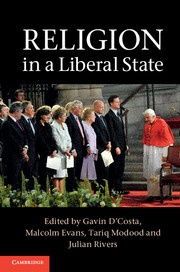Book contents
- Frontmatter
- Contents
- List of contributors
- Acknowledgements
- Introduction
- 1 Religion in a liberal state
- 2 The European Court of Human Rights and religious neutrality
- 3 Religion and sexual orientation: conflict or cohesion?
- 4 Liberal religion and illiberal secularism
- 5 Moderate secularism in liberal societies?
- 6 Excluded, included or foundational?
- 7 Justificatory secularism
- 8 What lacks is feeling: mediating reason and religion today
- 9 Arguing out of bounds: Christian eloquence and the end of Johannine liberalism
- Index
- References
Introduction
Published online by Cambridge University Press: 05 June 2014
- Frontmatter
- Contents
- List of contributors
- Acknowledgements
- Introduction
- 1 Religion in a liberal state
- 2 The European Court of Human Rights and religious neutrality
- 3 Religion and sexual orientation: conflict or cohesion?
- 4 Liberal religion and illiberal secularism
- 5 Moderate secularism in liberal societies?
- 6 Excluded, included or foundational?
- 7 Justificatory secularism
- 8 What lacks is feeling: mediating reason and religion today
- 9 Arguing out of bounds: Christian eloquence and the end of Johannine liberalism
- Index
- References
Summary
It is now a truism to observe that over the last decade religion has reasserted its presence in public consciousness. One must still question just how broad or how deep this reassertion is. Perhaps the secularization thesis – and its contemporary reversal – were only ever plausible in the contexts of Northern European liberal democracies. Perhaps, with hindsight, these societies had only ever experienced a temporary lull in the ‘furiosity’ of their religions (Berger, 1999). Perhaps the religion which is now reasserting itself is a set of peripheral concerns bound to come into conflict with surrounding culture and even masking, or responding to, a general decline (Bruce, 2011). Or perhaps surrounding cultures are themselves changing in ways which make religious beliefs and practices more unusual and more awkward to accommodate. But as all these questions suggest, the public presence of religion is widely perceived to represent a growing problem, which, however one might explain, receives concrete expression in increased political contestation and even litigation.
There are other more general and familiar trends which suggest that ‘the problem of religion’ is new, or at least has new dimensions. The first of these is globalization. Globalization in its technological manifestation enables real-time awareness of movements and events across the world, as well as networks of the like-minded, who might be mere mavericks at home. It is easy to forget that the Internet started being widely used only from the late 1990s. Globalization brings with it a strengthened awareness of diversity, which in turn is reflected in politicization as different options for the public and collective expression of religions vie for adherents. The sacred canopy has become a contest of importunate umbrella salesmen. Politicization in its turn feeds juridification, as disputants seek solutions by reference to legal norms and processes in desperate recourse to the only remainder of society’s ‘crumbling cement’ (Habermas, 1999).
- Type
- Chapter
- Information
- Religion in a Liberal State , pp. 1 - 8Publisher: Cambridge University PressPrint publication year: 2013
References
- 3
- Cited by



